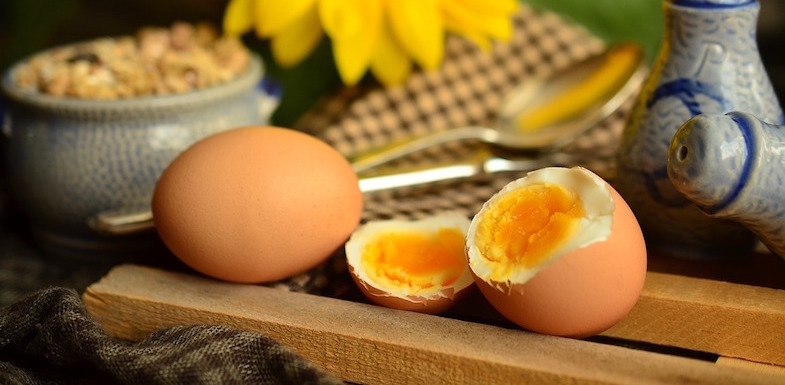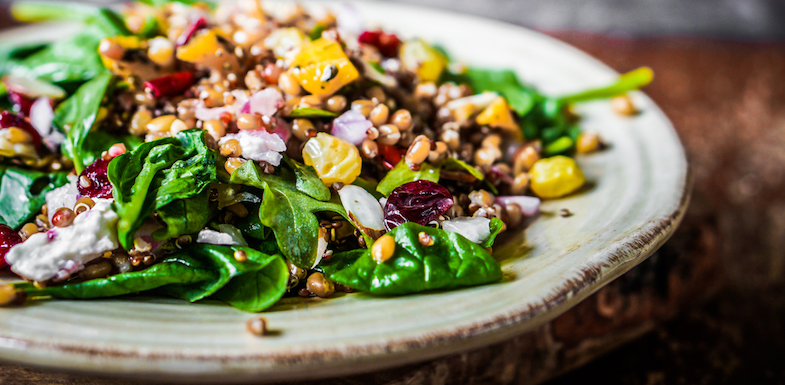A migraine can be an intense event that can ruin a whole day or even a week. It can be a chronic condition that you have to manage for most of your life, too. Throbbing pain in the head is the classic symptom of this disorder, but it is also known to be accompanied by vomiting, nausea, and sensitivity to light and sound. So it is easy to assume that if you do get migraines, you want to make sure you minimize them as much as possible. A migraine diet can help.
What is a migraine?
Migraine affects nearly 38 million people in the U.S. While throbbing head pain is the most widely-recognized symptom, other symptoms can include fatigue, nausea, and sensitivity to light and sound. When a migraine hits, the last thing on your mind might be food. Turns out, there are some foods that can actually help ease the pain of migraine while soothing other common symptoms.
A migraine diet made easy
We have put together a list of tasty and healthy foods that are rich in the vitamins and minerals that will help fight off migraines. We have also included some tips and tricks on crafting an overall better migraine diet, from what to avoid to what you should definitely eat. Finally, we rounded that up with a collection of “eat this, not that” recommendations at the end.
There has been quite a bit of research done on the correlation between certain foods and migraines. The results are usually classified into categories such as pain-safe foods that never contribute to headache and common triggers that often cause headaches. Everything else can fall in the middle and not all diet choices will be right for you.
Some triggers will affect you and some won’t, so it is always a smart idea to keep track of what you eat and how it affects you. You can use a daily activity journal to track and identify problem foods and activities to better understand how to mitigate your migraines. It is also a good idea to keep in mind that it could take several months to notice a sizeable difference when eliminating certain foods. Remember, changing your diet isn’t guaranteed to make you migraine-free, but it is a powerful tool in helping you reduce migraine episodes and pain overall.
1. Drink more water
Dehydration is one of the most common migraine triggers. Water is essential for the body to be healthy and function properly. Also, with the wide selection of sugary drinks and juices, we often forget that we aren’t drinking as much water as we should be. If you don’t like just drinking plain old H2O, you can always reach for other options like herbal tea and decaf coffee as they are mostly water and low in sugar and calories.
2. Eat more healthy fats
Some people still think fat is a bad word, but there are some major benefits to adding certain ones to your migraine diet. Omega-3 fatty acids, mainly found in fatty fish such as mackerel, tuna, and salmon, can really help with migraines. Olive oil is also another great source of healthy fat. The monounsaturated fats can be just as beneficial as omega-3s and they can be a healthy substitute in most recipes. Research has shown that they help reduce the frequency, pain level, and duration of migraines. Make sure you add in a healthy dose a few times a week to start seeing some positive changes.
3. Add magnesium to your diet
Magnesium is a great nutrient to add to your migraine diet. It can help with increasing energy, calming anxiety, and relieving digestive issues. It also has been shown to prevent and soothe migraine headaches of all types. Try adding spinach, quinoa, and whole grains to your diet as they are high in magnesium and other essential nutrients. If you can’t seem to fit in enough, magnesium supplements are an excellent alternative.
4. Don’t forget the riboflavin
Also known as vitamin B2, riboflavin has been shown to combat migraine incidents. Research shows that it can reduce migraines up to 50% when taking 400mg daily. B2 is also essential for metabolic energy production, so adding more of it can boost energy levels. Adding foods that are high in vitamin B2 like quinoa or asparagus can help you reach that 400mg mark.
5. Identify your trigger foods and construct a migraine diet plan
This is where the daily activity journal will do the most good. Since foods affect people differently, it helps to reset your diet to mostly safe foods to begin with. Trigger foods usually take about two days to start causing headaches again so you can then slowly add in foods you enjoy to see if they are the culprit for headaches.
Caution should be advised when changing your diet as there is no universal migraine diet that is right for everyone. A well-balanced diet is recommended. You should avoid skipping meals as this can have negative effects and actually exacerbate migraines.

Common migraine triggers
Here is a list of well-known trigger foods, so be careful if you want to add them to your diet.
- Alcohol: A small amount usually isn’t a problem, but certain liquors such as red wine or beer can be very powerful triggers for most people. If you are drinking, make sure to drink plenty of water as well because alcohol can cause dehydration.
- Aspartame: This can be found in artificial sweeteners that are often in diet drinks, low-calorie deserts, and yogurts.
- Additives: Be careful of additives in a variety of foods such as monosodium glutamate (MSG), sodium caseinate, and yeast extract.
- Nitrites: Nitrates are a preservative that is also used to add flavor to meat products. Nitrites are most frequently found in any food that is smoked, cured, pickled, or canned. Specifically, a high amount of this is most often found in deli meats, hotdogs, sausages, and jerky.
- Tyramine and phenylethylamine: These two amino acids are the most common food triggers for headaches. Make sure to be careful when eating chocolate, aged cheese, nuts, or soy food, as they have large concentration of these amino acids.
6. Eat this, not that for a migraine diet
Finally, we hope you enjoy these fun switches you can make to easily up your migraine diet to find relief.
Instead of: Fresh oranges for breakfast
You may think that eating plenty of citrus fruits is a good thing to begin your day, but for some people, fresh citrus can be a trigger. Plus, the added acid isn’t doing a stomach upset by migraine any favors.
Try: Cooked fruit such as pears or cherries
Compounds in tart cherries can ease inflammation, including inflammation that may make a migraine worse. Mixed in with some overnight oats, chia seeds, and rice milk, cooked cherries or pears help you work towards your daily recommended amount of fruit without increasing your pain.
Instead of: Products with wheat flour
For some people with migraine, wheat-based foods (bread, pasta, and crackers) may trigger or worsen migraine headaches. Wheat can also cause gastrointestinal problems for those who are sensitive to it. That’s the last thing you want if one of your migraine symptoms is nausea.
Try: Rice- or oat-based products
Gluten-free foods have come a long way in the last decade. Gone are the crumbly breads, hard crackers, mushy pastas, and dry muffins of the past. Rice-based pastas are especially well-tolerated for those with migraine, potentially due to the high magnesium and niacin content. Brown rice is also a staple part of the elimination diet that is often suggested to migraine sufferers in order to diagnose triggers.
Oat flour and oats in general are also an excellent, mild food for upset stomachs that can come with migraines. A migraine diet that includes oats for breakfast is a great start to the day.

Instead of: Coffee
Coffee and the effects of caffeine are hotly debated. For mild headaches, a bit of caffeine seems to help with the pain, but when it comes to a migraine diet, caffeine is a commonly identified trigger. But if you need a morning jolt of caffeine to just wake up, you may find yourself rolling the dice and gambling that this time it won’t be a trigger.
Try: Green tea (and others)
Green tea has caffeine in it, yes, but it also has other compounds that may help ease the pain of migraine. Pair it with ginger, skullcap, and feverfew for a morning drink that attacks multiple symptoms of migraine, including nausea. If you are used to caffeine in the morning, eliminating it totally may actually cause headaches. Replacing your normal cup of joe with green tea can help ease the transition and relieve pain at the same time.
Instead of: Soy products
As a migraine sufferer, you have probably tried a plant-based diet to help ease the symptoms of migraine. But you find that soy triggers migraine just as much as a big, juicy burger. So what do you do for protein?
Try: Beans and nuts of all kinds
If your migraines are triggered by fluctuating hormones, soy products can exacerbate that and cause headaches. Soy products are also processed so much as to be unhealthy in general. Instead of focusing on soy for your protein needs, look towards a wide array of beans. Beans such as navy beans, pinto beans, lima beans, and kidney beans, and nuts and seeds like pumpkin seeds, sesame seeds, sunflower seeds, cashews, and almonds contain protein and magnesium, a migraine-fighting mineral that many in the U.S. are deficient in.
Beans are affordable, versatile, and delicious, with a seemingly endless array of recipe options. You won’t miss meat or soy.
Instead of: Raw vegetables
As we move into summer, fresh raw vegetables look more and more appetizing. It makes sense that when the days heat up, we like to cool down, staying out of the kitchen and taking advantage of the farmer’s market bounty. But in addition to the triggering effect of hotter temperatures and a rising barometer, many raw fruits and vegetables like corn, tomatoes, onions, apples, and bananas can also set off migraine pain. It can be a catch-22, deciding between migraine pain and getting the health benefits of vegetables.
Try: Cooked vegetables
While some experts disagree with the idea that certain vegetables can trigger migraines, if they do bother you, skip them and reach for foods that have never been linked to migraines, such as leafy greens, broccoli, carrots, squash, and sweet potatoes. These vegetables are filled with antioxidants and may also be anti-inflammatory. Steam or roast them lightly on the grill to retain their nutrients and keep your house cool in the summer months.
Instead of: Ice cream or frozen yogurt
Nothing says summer like a big bowl full of ice cream or frozen yogurt, but dairy and sugar can trigger and increase migraine pain exponentially. Is it really worth it?
Try: Mango berry “nice cream”
Most of the dairy-free “nice cream” circulating around the web these days feature bananas and coconut milk, two foods to skip on a migraine diet. This mango berry nice cream is rich and sweet with no added sugar. Berries are at their very best in the summer. To take advantage of this treat year-round, freeze them first on cookie sheets. Then put them in pre-measured bags for a quick frozen treat whenever the urge strikes!
If you need more directed help with your migraine headaches, talk to a pain doctor today to learn about treatment options that could help you. Click here to contact one of our pain specialists.
